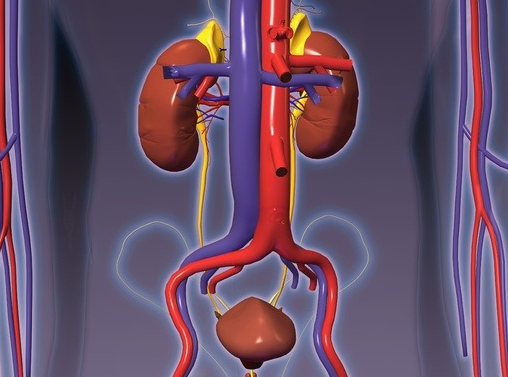So I'd like to --let me start the pulmonary circulation,
我们先介绍一下肺循环
where you can see that the pulmonary artery and vein --
大家可以分别看到肺动脉和肺静脉
I'll start that, just to really emphasize the point,
之所以要强调这里
or actually the reverse of what I've just said, right?
因为这跟我们刚介绍的是相反的
Because the pulmonary artery is actually gonna carry the deoxygenated blood,
大家看肺动脉输送的是缺氧血
and the pulmonary vein is carrying the oxygenated blood.
而肺静脉输送的则是含氧血
So clearly that's the reverse of what I've just said.
很明显,这跟刚才介绍的是相反的
But that is one exception to the general rule,
这是一个特例
which is that arteries definitely look red, and veins generally look blue.
一般来说动脉是红色的,静脉是蓝色的
Okay, so that --those are two points of difference between the arteries and veins.
这是动脉和静脉之间两个不同点
Let's keep going.
我们接着看

So now you know, that arteries are high pressure, right?
我们知道,动脉内血压很高
because the heart is pumping the blood out,
因为心脏把血液挤压输送出来
and it's gonna be in a very very high pressure.
所以动脉血血压很高
And so I kind of think of the arteries as being like a river, a fast flowing river.
如果把血管比喻成河流,动脉就是非常湍急的河流
So you can think of this as fast flowing, high pressure.
压力很大,流速很快
So that is the third difference. This is a high pressure system.
这是它们的第三个不同点,动脉中血压很高
Third difference, it's that it's high pressure system.
动脉的血压很高
In fact, maybe I'll even emphasize the point by writing the word very large:
为了强调这点,我写大一点
HIGH PRESSURE.
血压很高
And actually, the other thing we think about with arteries is that
大家想一下,动脉还有一个特点
there is not so much volume in the arteries.
动脉中血量并不大
So if you actually look at --let's say, froze time now,
假设我们现在停住时间
you should try to figure out where all the blood was located, not too much of it is in the arteries.
我们来看血液的位置,在动脉中的血液不会太多
So it's actually a very low volume system. I'll write volume very small.
动脉中血量很小
And the veins are the opposite.
静脉恰恰相反
They're kind of a large volume-- system.
静脉血量是很大的
And they have really kind of low pressures.
而血压相对较低
I'll write pressure very small over here.
血压较低
And if you actually figured out what percent is where, in terms of the amount of blood,
如果要用百分比表示各部位血量的话
about 5% of the blood, at any point of time, would be in the heart.
心脏中大约会有5%的血量
And --let's say, about 5% would be in the capillaries.
5%在毛细血管中
And then about 10% or so, would be in the lungs.
大约有10%的血存在肺部
So what we have to --now we're 5 and 5 is 10, 10 plus 10 is 20.
5+5=10 10+10=20,已经介绍了20%的血量
And then we have another about 15% in the arteries. So about 15%.
大约15%的血量在动脉中
So that's actually not too much blood.
这个血量并不大
And so the remaining --what is that, 65% of the blood, is actually in the vein, at any point of time.
剩下的65%的血液都在静脉中
So that's remarkable, right?
这个血量是很大的
About two thirds of the blood at any point of time is actually sitting in all the vein combined.
在某时刻,身体的2/3的血液在静脉中
And so the way I've drawn it, isn't really --not really a best way to draw it.
大家看我画的图示,这个不太形象
I should really erase this.
重新画一下
And really redraw this to make it much more accurate.
如果要对应血量来画的话
It should look a lot more like this, right, like a big giant lake of blood.
应该这么画,静脉要粗很多
And so this is actually how to think about of the veins.
这是静脉的特点
It's actually a very very low pressure but high volume system.
血压低,而血量很大
So that might be the third point.
这是第三个不同点
I'll bring up on the blood side --or, on the vein side.
我写在静脉这边
Is that it's a high volume system. so, high volume.
静脉血量大












